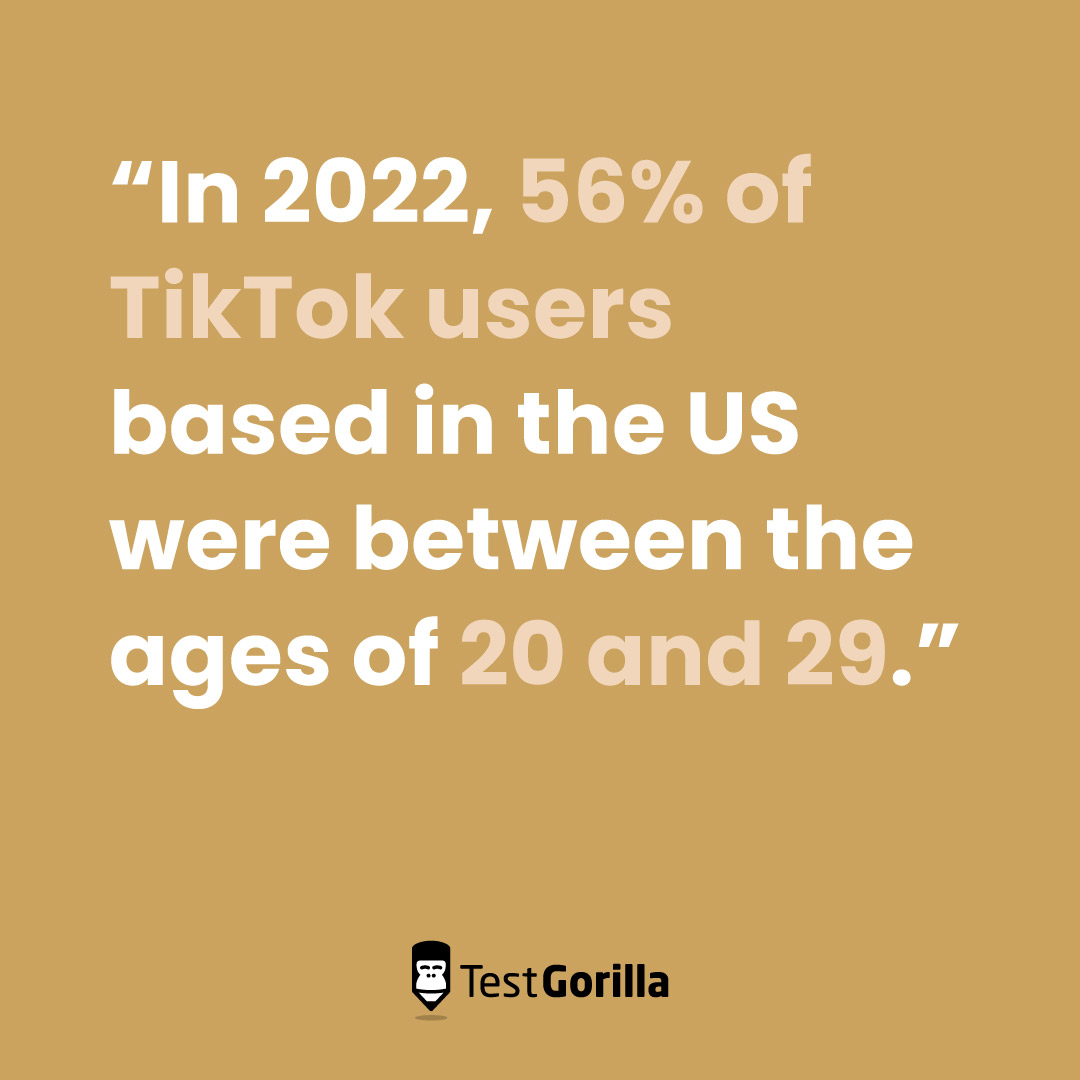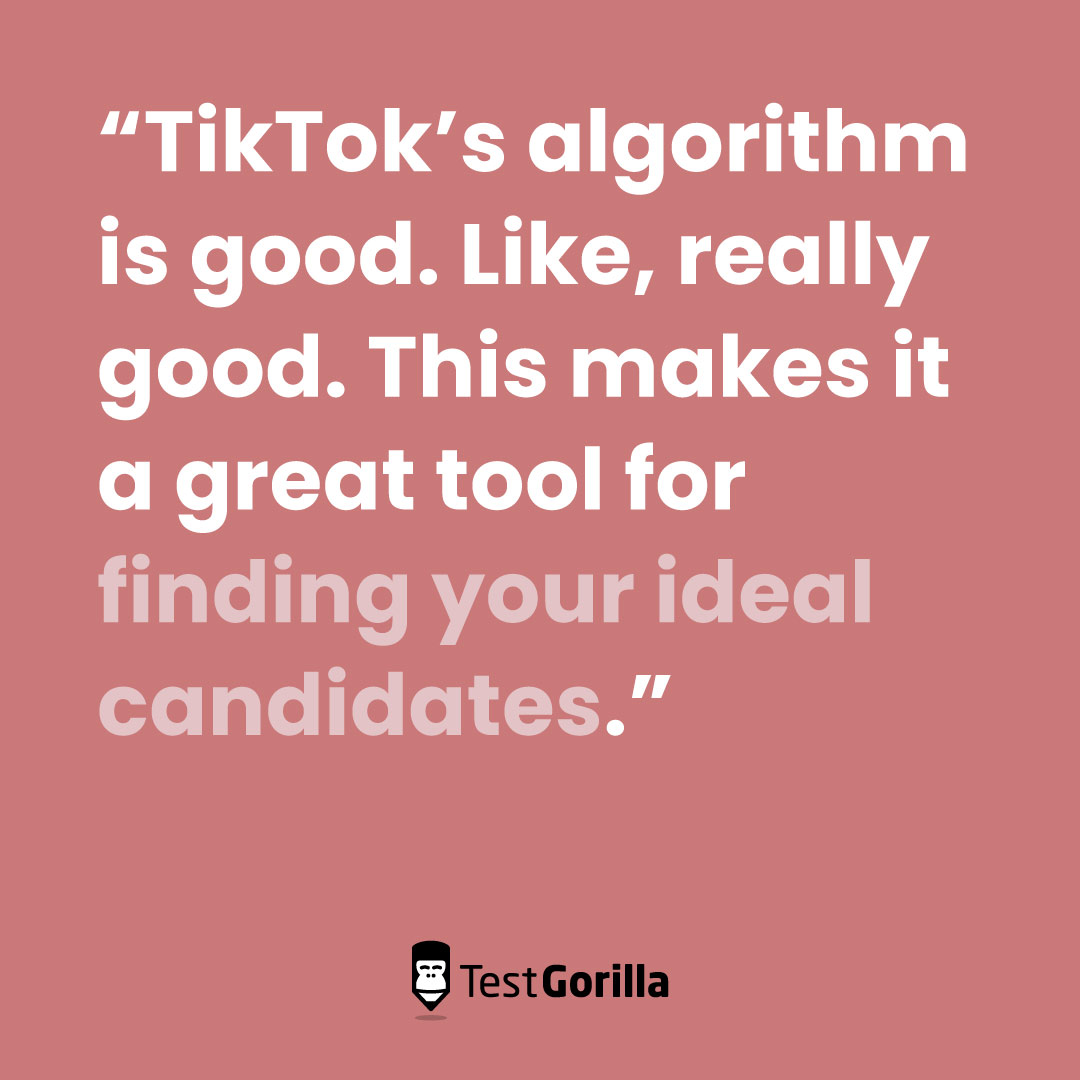TikTok isn’t just viral dances, sound clips, and hot takes. It’s a social platform that people are turning to more and more as a place to get information, including info about employers.
The popularity of the app has opened a new and exciting frontier for recruiters and hiring managers looking to find top talent for their workplaces. And, in case you were wondering, younger generations of job seekers are absolutely applying for jobs they found through social media.
Luckily, you don’t have to be a part of Gen Z to effectively recruit them into your workplace. You can simply integrate TikTok into your recruitment strategy.
TikTok is an excellent way to attract highly skilled workers. You can create videos that tap into its algorithm to give prospects a glimpse of what it’s like to actually work at your company, promote open roles, and even offer tips on what you’re looking for in a new hire.
If you add TikTok to your recruitment toolkit, you can make your existing hiring practices even stronger – and you'll have the eyes and ears of all the talented candidates who are spending time there.
Table of contents
Who’s really using TikTok, anyway?
TikTok may be marketed for younger audiences, but you’d be surprised to learn it’s not high schoolers who make up a majority of its users.
In 2022, 56% of TikTok users based in the US were between the ages of 20 and 29. So companies that use TikTok in their recruitment strategy are primarily targeting younger millennials and older Gen Z-ers – two generational cohorts poised to make up the bulk of the global workforce in just a few years.
Research from DataReportal also shows us that the platform is nearly evenly split between men and women.
TikTok users who find your company’s content on the platform are likely to engage with your business in some other way beyond simply watching your videos. Case in point: 92% of TikTok users claim they’ve taken an action with a brand after watching a TikTok video.
That number makes a compelling argument to get on TikTok to share your company’s culture and promote open roles. And many recruiters are already there.
Recruiters are jumping on the TikTok bandwagon – and so can you
TikTok self-identifies as an entertainment platform for content creators to share the things that inspire them, from baking to traveling and everything in between. But now, it has also recognized its potential as a job discovery channel for companies to recruit top talent.
In 2021, TikTok launched the pilot program #TikTokResumes. This program was created as a formal, TikTok-driven response to the popular crowdsourced hashtag #CareerTok.
The platform built partnerships with some of the most sought-after companies, like Chipotle, Shopify, and Alo Yoga. The goal was to encourage entry-level job seekers to upload TikTok resumes specifically for recruiters.
Applicants used their videos to hype their skills, their knowledge of the company they were interested in, and their enthusiasm for the role. They would then tag the company in the caption. Recruiters reviewed all the video resumes and made hiring decisions based on the strongest ones.
Companies that didn’t partner with TikTok for the pilot program are able to take advantage of the platform in similar ways. Plenty of companies use the platform to announce job openings; some share job interview tips and tricks, or post content that highlights your company’s culture and values.
4 ways to use TikTok for recruitment
Interested in how you can use TikTok for your recruitment strategy? Here are our 4 top tips for TikTok hiring.
1. Use the algorithm to grab job-seeking eyes
TikTok’s algorithm is good. Like, really good. This makes it a great tool for finding your ideal candidates.
TikTok’s recommendation system shows users content it thinks they’ll like based on a ton of factors, like prior engagement on the app, account settings, and personal interests. The algorithm collects actions you take on the app – like searching for a topic or commenting on a video – and uses them to make assumptions about the kind of content you’d enjoy watching.
As a content creator, you want to get picked up by the TikTok algorithm. It’s a surefire way to increase your views, boost engagement, and ensure your content is enjoyed by people in your industry. There are a few ways to embrace the algorithm:
Play into your subculture. Seventy-six percent of users on TikTok like it when brands or companies cater to their unique interests, like airlines that participate in #TravelTok.
Grab user attention fast. The first two seconds of a video are the most important to keep someone engaged.
Fill your captions with juicy keywords. TikTok uses the basic principles of SEO to scan captions for keywords. It’ll boost trending content to more viewers based on the topics people search for the most.
Using the algorithm to your advantage will help you grab recruits who are skilled in your industry. Check out TikTok’s Creative Center to find top keywords in your industry.
2. Announce a job opening, TikTok style
More than 40% of job seekers agree that social media is important to a job search. You can use social media to your advantage by posting about open roles at your company and encouraging viewers to apply through the link in your profile.
Because TikTok is a less formal space – think entertainment-first rather than education-first – you can get creative with videos that are short, quippy, and playful.
That’s exactly the approach taken by New Zealand-based marketing agency The Attention Seeker. In this video, the agency announces an open role for a copywriter and account lead. It relies on humor to engage with viewers, breaking down the job description in a unique way.
Its efforts paid off, and the video went viral, gaining 44,000 likes and over 200 comments – and likely some top-notch applicants.
3. Share your expertise
Short and quippy videos work well to prime potential applicants about the things you want to see in an interview.
You’re the expert on what people in your audience want to see – and TikTok loves when a user creates content talking about their area of expertise. Use this to your advantage to make quality content that speaks directly to the biggest pain points, wins, and challenges within your industry. The more you do, the more like you are to be rewarded with content that goes viral.
Duolingo has a cult-like following on TikTok, with fans rallying behind videos of its mascot, Duo. The character keeps it fun; the expertise keeps it useful.
The company partnered with Handshake to share interview tips to get students and recent grads hired at entry-level positions. While a rep from Handshake calls out the “green flags” recruiters look for, Duo dances in the background.
The video also does double duty as an ad space, pointing out that Duolingo was named a 2022 Early Talent Award winner for being a great place for Gen Z to work.
4. Highlight company culture and values
Use TikTok to show off your company culture by creating content that speaks to the everyday experience of your employees.
Videos don’t need to be highly editorialized and polished in order to be effective. They can be low-tech, using just a smartphone camera and some imagination.
Ask for permission from your employees before filming them or posting content about them on the internet. You might consider encouraging your employees to create content themselves and tag you.
You can then treat that content like user-generated content (UGC), reposting it to your own profile to get even more viewers. The Washington Post uses TikTok not only to talk about the news but also to highlight its workforce (in this instance, they joke about interns stealing food).
Its videos give a playful look into what it’s like to work at the newspaper and humanize its workers. The end result is not only entertaining but also gives a genuine insight into the kinds of people future employees will get to work with.
Integrate TikTok into your recruitment strategy
In 2021, TikTok briefly upended Google’s reign as the most visited domain in the world. Today, it still remains in the top 10 most popular websites.
Today, the average TikTok user spends about 55 minutes a day scrolling through the platform. This means there’s a high chance your ideal hire could come across your video.
TikTok 🤝 TestGorilla
Once you’ve grabbed their attention, make sure they’ve got the skills for the job by giving them assessments from our free library of skills-based tests. Skills-based assessments help you make objective and data-driven hiring decisions based on a number of factors, like knowledge of your industry, personal values, and skill sets. After all, if candidates can lie on their paper resumes, they can lie on their TikTok resumes too!
Related posts
Hire the best candidates with TestGorilla
Create pre-employment assessments in minutes to screen candidates, save time, and hire the best talent.
Latest posts
The best advice in pre-employment testing, in your inbox.
No spam. Unsubscribe at any time.

Hire the best. No bias. No stress.
Our screening tests identify the best candidates and make your hiring decisions faster, easier, and bias-free.
Free resources
This checklist covers key features you should look for when choosing a skills testing platform
This resource will help you develop an onboarding checklist for new hires.
How to assess your candidates' attention to detail.
Learn how to get human resources certified through HRCI or SHRM.
Learn how you can improve the level of talent at your company.
Learn how CapitalT reduced hiring bias with online skills assessments.
Learn how to make the resume process more efficient and more effective.
Improve your hiring strategy with these 7 critical recruitment metrics.
Learn how Sukhi decreased time spent reviewing resumes by 83%!
Hire more efficiently with these hacks that 99% of recruiters aren't using.
Make a business case for diversity and inclusion initiatives with this data.





















